SCAM ALERT: DO NOT BUY FROM RANTHY<dot>COM
RANTHY<dot>COM IS A SCAM
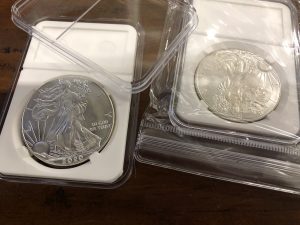
Two counterfeit American Silver Eagles purchased from a company based in China who advertised on Facebook.
NO LEGITIMATE DEALER IS SELLING BULLION COINS FOR BELOW THE SPOT PRICE!
The current price of silver is $23.86 per troy ounce. If anyone is selling American Silver Eagles for less, they are likely selling counterfeit coins.
Questions about the site sent today noted that the scammers advertised these coins on Facebook.
These scammers are not selling 2022 American Silver Eagle counterfeits because the Chinese manufacturers of the fakes have not created bogus Type 2 reverses. Remember, legitimate dealers will sell coins with the Type 1 reserve. They will also sell the coins with the Type 2 reverse.
IF YOU PURCHASED COINS FROM THESE SCAMMERS, contact your credit card company and dispute the charge. If you received the coins and they are counterfeit, contact your credit card company and dispute the charge.
IF THERE ARE ANY QUESTIONS ABOUT A WEBSITE, THEN DON’T PURCHASE FROM THEM!
DON’T MICROWAVE YOUR MONEY!

Image from Reddit
Microwaves work by shooting electrons at whatever it finds. The electrons create friction as it passes through the surfaces and generates heat. These electrons cannot pass through a metal surface. When you try to microwave metal, you will see sparks as the electrons skip over the metal surface.
Some chefs have discovered ways of using aluminum foil to direct the electrons to use the skipping electrons to add extra heat to one area of the food. As part of the process, the electrons speed up before finding someplace to go. Another technique is to cover areas to minimize the reaction.
Regardless of how you try to control the flow of electrons, they have to find someplace to go. The reaction is the basis of chemistry. A free electron looks to bond with an atom that has more protons than electrons. It balances the equation.
This basic science lesson is to help explain why you do not want to microwave your currency.
You might have heard that using your microwave oven would help kill the COVID-19 virus. Some research says it is plausible, but the idea is for food. If you have any questions about whether your takeout order is safe, put it in your microwave. You can also heat your food in an oven or on your stovetop. As long as you cook the food to over 140°F (60°C), you will kill most pathogens.
But what happens when you put money in your microwave? It will burn!
The Bureau of Engraving and Printing has produced currency notes with a security thread to thwart counterfeiting since 2003. The security thread is a thin ribbon of metal embedded into the currency paper. Hold the currency up to the light, and it will tell you what the denomination should be. On the $100 note, it is a wider strip with a distinct look.
When you microwave money, the electrons will strike the metal thread, pick up speed, and look for a place to land. The next softest material is the currency paper around the security thread. The increase in friction on the currency paper will cause the paper to burn.
Think of it like this: rub your hands together for a few seconds. You will feel your skin begin to heat. Now multiply your hand rubbing by the speed of an electron flying by, and the friction will burn your hands. That is what is happening to the paper.
If you do burn currency paper, bring all the pieces to your bank. The bank will exchange the notes for ones that are not burned and will send them back to the Federal Reserve for disposal.
CLEANING MONEY
First, if you are working with collectibles, DO NOT CLEAN YOUR COLLECTIBLE COINS AND CURRENCY! Cleaning collectible coins, currency, tokens, and medals will reduce their collector value. Just don’t do it!
There are many ways you can clean your circulating pocket change. You can wipe them with a disinfectant, including 70% rubbing alcohol or a household wipe that contains alcohol and Dimethylbenzyl Ammonium Chloride (Clorox and Lyson bleach-free wipes contain this chemical). Another method is to wash coins using warm water and a dish cleaning detergent. Finally, leave coins in your pocket when you wash your pants. The only problem with washing coins with clothes is the racket your dryer will make, and you may dent the drum. Currency may require a warm iron to make flat again.
Another method is using ultra-violet (UV) light.
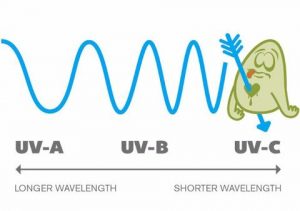
Image courtesy of Phonesoap, a smartphone cleaning device that uses UV-C light.
The short wavelength of UV-C light will penetrate cell walls and kill the DNA within the cells. We are protected from the Sun’s UV-C light by the Ozone Layer of the Earth’s atmosphere. By destroying the Ozone Layer, we let the Sun’s UV-C light penetrate the atmosphere increasing skin cancers.
While UV-C is altering your DNA to create cancers, it is also killing germs using the same properties to alter its DNA.
You can buy lightbulbs that generate UV-C light. However, if you create a UV-C disinfecting station, be careful. Shining UV-C light randomly will cause skin damage worse than a tanning bed. A tanning bed mixes the spectrum of UV light and filter most UV-C light. But a dedicated UV-C light is not good for your body.
Since UV-C light does not generate a lot of heat, you can create an enclosed disinfecting station using almost any material. One example is to create a box using poster board with the edges sealed with duct tape. Cut a hole in the top for the light and then seal the hole with the duct tape. Place your currency inside the box and leave it for 15 minutes.
If you spend a little more money, you could purchase a wall timer. Set the time for the light to turn on after you leave the room and to turn off 15 minutes later. Do not go into the room until the process completes.
There are commercially made devices made with sealed chambers and timers.
Finally, if you want the safest way to disinfect your money, place it in a plastic bag that seals. Close the bag most of the way. Leave about an inch unsealed. Then let the bag sit in a sunny area for about 24 hours. The natural UV-C light will disinfect the money. When you are ready, remove the money and throw the bag away. Use a clean bag for the next round.
Of course, you can avoid all of this by using a credit card that you can clean with a disinfecting wipe when you get home. Contactless payments, like Apple Pay, Google Pay, and Samsung Pay are also alternatives to paying with cash.
Quarantine Reading List: History of US Money Manufacturing
With the announcement that the coalition of northeast states will continue their stay-at-home order at least through May 15, it is time to turn off the news and think about something else.
Since the kids are doing their homework without a teacher, you can pick up a book or two and learn something about the hobby we love.
The inspiration for today’s Quarantine Reading List came from a reader asking about the history surrounding the institutions that create the numismatic products.
Although many books explain the manufacturing processes and describe the history, the goal of this list is to suggest well written and accessible books on each topic. If the publication is available online, there will be a link to read it or download a copy.
U.S. Mint
 Of all the money manufacturing institutions, the U.S. Mint has the most documented history. There are so many good books about the Mint’s history it is difficult to narrow down a recommendation to one book. If you are going to read one book, read History Of The United States Mint and Its Coinage by David Lange.
Of all the money manufacturing institutions, the U.S. Mint has the most documented history. There are so many good books about the Mint’s history it is difficult to narrow down a recommendation to one book. If you are going to read one book, read History Of The United States Mint and Its Coinage by David Lange.
Whether you read for knowledge or pleasure, it is always best when it is well written. David Lange’s reputation as a great writer is on full display in this book. Using his skill, Lange writes a broad context of the history of the U.S. Mint fitting it in 190 pages with images of coins, vignettes, and documents of the time. After you finish, give the book to your young numismatist who will also enjoy it.
History Of The United States Mint and Its Coinage is no longer in print but can be found on the secondary and used book market.
Bureau of Engraving and Printing
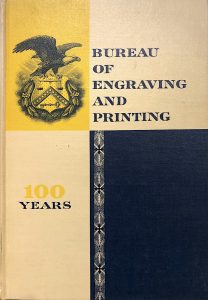 The Bureau of Engraving and Printing started in 1862 in the basement of the Treasury Building as the National Currency Bureau. Their first job was to separate currency notes produced by private banknote printing companies. The newly formed bureau started its printing operations in 1863.
The Bureau of Engraving and Printing started in 1862 in the basement of the Treasury Building as the National Currency Bureau. Their first job was to separate currency notes produced by private banknote printing companies. The newly formed bureau started its printing operations in 1863.
The BEP grew out of the necessity to fund the Civil War. From there, the bureau became the primary security printing service for the government. To learn more about the BEP and its growth, read History of the Bureau of Engraving and Printing. Produced for the 100th Anniversary of the BEP, the book is the most comprehensive coverage of its history.
For those looking to save money, the book is available online. It does not have copyright restrictions since it was produced by the BEP and printed by the Government Printing Office. You can download the book in many electronic formats from Newman Numismatic Portal and the Internet Archives. Download the book now and start reading!
Department of the Treasury
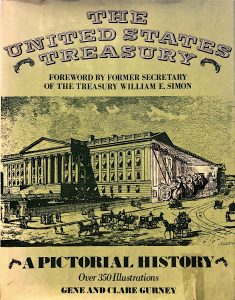 The Treasury Department is the only Cabinet-level department whose history mirrors the country’s history. Although there has been a lot written about Treasury, most of the book covers a specific era of history. Whether the subject is the founding of the department by Alexander Hamilton, the Gold Rush era, or the transition to working with the Federal Reserve starting in 1913, you can find a book that will expand on Treasury’s history.
The Treasury Department is the only Cabinet-level department whose history mirrors the country’s history. Although there has been a lot written about Treasury, most of the book covers a specific era of history. Whether the subject is the founding of the department by Alexander Hamilton, the Gold Rush era, or the transition to working with the Federal Reserve starting in 1913, you can find a book that will expand on Treasury’s history.
For a good overview that discusses the history of the department and reconizes the production of money through the years is The United States Treasury: A Pictorial History by Gene and Clare Gurney.
Written in 1978, it is not an academic study of the Treasury Department. The book provides a pictorial overview along with the story of Treasury with over 350 illustrations in 216 pages.
Of course, you can buy the book and have it as a perpetual reference. If you want to “borrow” an electronic book, you can do so at the Internet Archives. Once you create a free account on the Internet Archives, you can check out an electronic version for two weeks.
Commission of Fine Arts
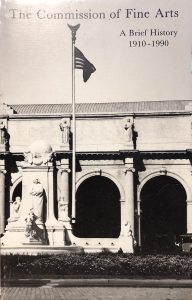 Although the Commission of Fine Arts is not part of the manufacture of money, it wields influence on the designs of the coins struck by the U.S. Mint. The first influence the CFA had on coin design was for the 1921 Peace Dollar. It was the CFA that managed and selected the competition that was won by Anthony de Francisci.
Although the Commission of Fine Arts is not part of the manufacture of money, it wields influence on the designs of the coins struck by the U.S. Mint. The first influence the CFA had on coin design was for the 1921 Peace Dollar. It was the CFA that managed and selected the competition that was won by Anthony de Francisci.
In 1976, the CFA published the initial version of the commission’s history. They produced updates every five years with the last published in 1996 that covers its history through 1995. Most of the book does not mention its ties to numismatics until the 1985-1990 additions.
It is difficult to find physical copies of the later version of the book. The most common version found on the secondary market was the one published in 1986, before their involvement with the American Eagle program. But as a government publication, it is available online at the Internet Archive. As with other electronic books downloadable from the Internet Archive, it is available in many different formats depending on your device.
SUMMARY
- History Of The United States Mint and Its Coinage by David Lange.
- History of the Bureau of Engraving and Printing can be read online from the Internet Archives,
- The United States Treasury: A Pictorial History or borrow an online ebook from the Internet Archives.
- Download a copy of The Commission of Fine Arts: A Brief History 1910—1995 from the Internet Archives.
Reading is an excellent way to pass the time.
Stay healthy! Stay safe!
NATIONAL COIN WEEK: Join the ANA FREE
 Now is the time for all collectors to join the ANA!
Now is the time for all collectors to join the ANA!
FOR FREE!
Yes, you read that right. FREE!
During National Coin Week, the Numismatic Guarantee Corporation (NGC), is paying for GOLD MEMBERSHIP to new ANA Members. That’s a $28 value.
What do you get for FREE?
- Digital subscription to The Numismatist Magazine with content that is not available anywhere else. You will also have access to the electronic archive of every issue of The Numismatist published from its founding in 1888.
- Access to the ANA Education Programs including all of the education content on money.org. You will also get free access to the National Money Show and the World’s Fair of Money to take advantage of those education opportunities, including the Money Talks session and exclusive content on money.org.
- Access to the World’s Largest Numismatic Library! They have more than books. The collection includes auction catalogs, videos, DVDs and slide sets. And you don’t have to go to Colorado Springs (but you might want to go see the Museum). Items can be mailed to you for the cost of postage. The staff is also very helpful and can provide research services (for an extra fee).
- Exclusive Discounts beyond the FREE admission to the shows.
- While you are stuck at home and going through your collection, as an ANA member you can directly submit coins to NGC and currency to PNG for grading.
Want to learn more about the ANA benefits? Read the ANA’s member benefit brouchure → HERE!
You can’t beat that at twice the price!
Well? What are you waiting for! CLICK HERE and join for FREE!
Weekly World Numismatic News for April 19, 2020
Glenna Goodacre, the designer of the Sacagawea Dollar and world-renown sculptor, died at her home in Santa Fe, New Mexico of natural causes. She was 80 years old.
Amongst her better-known works include the Vietnam Women’s Memorial on the National Mall in Washington, DC. Goodacre also created the 8-foot standing portrait of President Ronald W. Reagan at the Reagan Library in Simi Valley, California.

The unveiling of the Sacagawea Dollar design at the White House with (L-R) irst Lady Hillary Clinton, Sacagawea Model Randy’L He-dow Teton, and Designer Glenna Goodacre.
Numismatists know Goodacre for the design of the Sacagawea Dollar. Since there are no images of Sacagawea, the Shoshone guide of the Lewis and Clark expedition, Goodacre found Randy’L He-Dow Teton, a member of the Shoshone-Cree tribe, to be her model. The resulting profile of Sacagawea in three-quarter view and her infant son, Jean Baptiste Charbonneau, carried on her back has been produced for 20 years.
In 2018, Goodacre donated several plaster and bronze casts of the coin that was used to test the design and show the relief of the coin. There is also a plaster cast with an alternate version without her baby on her back.
As Dennis Tucker wrote in her memory, “The numismatic community joins Glenna Goodacre’s family, friends, and many fans in mourning her loss and celebrating her art.”
And now the news…
 → Read more at huffpost.com
→ Read more at huffpost.com
 → Read more at dailymail.co.uk
→ Read more at dailymail.co.uk
 → Read more at finance.yahoo.com
→ Read more at finance.yahoo.com
 → Read more at kitco.com
→ Read more at kitco.com
 → Read more at irishexaminer.com
→ Read more at irishexaminer.com
 → Read more at mirror.co.uk
→ Read more at mirror.co.uk
Follow up: FAQ on ANA’s Online Education #Fail
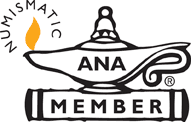 The feedback from my post, “Why the ANA does not have online education,” was interesting. About 10-percent of the readers (based on collected statistics) commented to me via email. That is a lot of feedback for one post! The comments ranged from a virtual headshake to anger for being “disrespectful” to the ANA president.
The feedback from my post, “Why the ANA does not have online education,” was interesting. About 10-percent of the readers (based on collected statistics) commented to me via email. That is a lot of feedback for one post! The comments ranged from a virtual headshake to anger for being “disrespectful” to the ANA president.
Unfortunately, nobody will go on the record with their comments. Please remember that I welcome all comments and will allow you to post any criticism you want. I accept and post all feedback, especially if you disagree with me. All I ask is that you keep it clean.
I want to answer two questions publically:
1. You’re the head of the IT Committee, why don’t you do something about the situation?
I am not longer the chairman of the IT committee, and I am no longer a member of the committee.
In late November 2019, ANA President Steve Ellsworth removed me from the committee after seven years of service.
When Ellsworth called to tell me, he did not give the exact reason. His statements as to why he made the decision were vague and ambiguous. Later that same day, I had to send him an email for clarification.
I assume that he did not want me around. After all, I came out against his candidacy before the end of the last election. But Ellsworth had a problem. How could he remove a recipient of the Glenn Smedley Award from the position that was the reason for the honor?
Unfortunately, I gave Ellsworth a way out. After he took office, Ellsworth changed a few things, including wanting status reports and a strategic plan. When he told me about the strategic plan, Ellsworth said that the ANA did not have one in many years and should come up with one.
At the same time, my business picked up. I was working 18 hour days, instead of my usual 14 hours, and had to hire more people. While my business was good, it did not provide enough time to devote to the ANA. I was hoping to catch up in late October, but that did not happen.
With the ANA not being a priority and my inability to deliver whatever Ellsworth wanted, I gave him the excuse to get rid of me.
Ellsworth’s move was a bit punitive, but it pales in comparison to what he hass done to the Exhibition Committee. That is a story for another time.
2. Can’t the ANA use something like Zoom to create classes?
YES!
They can also use software like Microsoft Teams, Google Hangouts, GoToMeeting, WebEx, and Skype. Any video conferencing software and presentation slides that can be shared can create an instant class environment.
Google Hangouts and Skype are suitable for small classes. Although both are known to have bandwidth issues, keeping the courses between 7-10 people make these an inexpensive option.
Zoom is the current darling of the industry since they have a free tier. While Zoom has some excellent features, its security issues have shown they are going through significant growing pains. It is like watching your teenage son grow six inches in two months while his voice is changing. Eventually, he will evolve, and so will Zoom.
WebEx and GoToMeeting are the old stalwarts of the industry. Both have the advantage of being mature and familiar to many in the business world. The significant difference between these services and Zoom is that Zoom makes it easier to connect to a meeting.
Another option is YouTube Live. Classes can be live streamed with any number of people tuning in. Interacting with a YouTube Live stream is via comments only, similar to Facebook Live, but it is something that the ANA can use.
Here is an idea: How about a YouTube Live class for Numismatics 101? After the live class, leave the video online with an email link to allow future viewers to send questions.
There are better ways to hold online classes. Blackboard and similar software have better options. But to start, do something!
